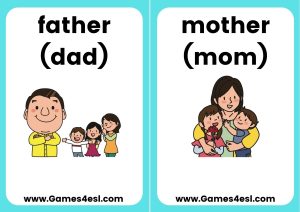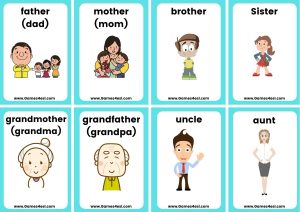Adding a Family Member to Apple Family Says Already a Member

This family unit lesson plan is smashing for educational activity kids and beginner English language learners nearly the members of the family in English language. Learning vocabulary and expressions most family and family unit members is essential for ESL learners, both young and old. Everyone has relatives so this topic is something everyone tin relate to. Learning to talk about families connects students' existent life experiences with what they learn in the classroom, which is great for language learning.
On this page you tin discover complete ESL lesson plan almost family and family members. This lesson plan includes all the materials you demand including PDF flashcards, educatee cards and board games. The games and activities on this folio will have your students talking about their families in no fourth dimension.
This lesson programme is mainly aimed at kids / beginner learners of English. Come across the beneath to download all the materials needed for this lesson. In improver, at the bottom of this page you tin find additional materials to teach most family members to ESL learners.
Materials for this lesson:
- Flashcards – Family
- Student Cards – Family unit
Family Lesson Programme
Introduce the Topic, Keywords and Expression

Before educational activity the key words for the lesson, information technology is important to put the lesson into context so that students understand what they volition larn. This will as well activate the students existing cognition about family vocabulary.
The easiest fashion to contextualize a lesson virtually family is to show students pictures of your family. Showing your family will likely be very interesting to your students, particularly if you lot teach young learners. Bear witness students pictures of your family and ask them to guess who they are. For example, prove them a picture of your brother / sis and ask them to guess how they are related to you lot.
This tin can pb to some funny answers, especially with kids every bit they don't always have a great concept of age. In many of my classes over the years, kids normally estimate that my older blood brother is my dad, and my dad is my granddad.
Adjacent, practice the key words for the lesson using thesefamily member flashcards. Show students the flashcard one by 1 and ask them to repeat after you. Then, evidence students over again and ask them to say the words on their own.
Once students accept practiced several times, information technology's time to introduce the fundamental expressions you will utilise during the lesson. The primal expressions yous use will depend on the age and level of your students, and your particular curriculum. Hither are a few case sentences you can use while teaching a lesson on family:
- Who's this/that? – This is my (father).
- Who's he/she – He/She is my (brother/sister).
- What does your father/mother do? – He/She is a (pilot).
- How many brothers and sisters do you have? – I have two brothers and ane sister.
Activity i: Nice To Meet Yous Game
After introducing the key words and expressions, information technology's time for a fun game to practice some more. This activity involves the whole class and requires a set offamily flashcards.
How To Play:
Place thefamily flashcards on the board in a horizontal line. Then dissever the class into 2 teams. Adjacent, the two teams should line upwards at opposite ends of the line of flashcards. One student from each squad should move down the line towards each other, touching each flashcard and saying the key sentence as they go. For example, 'This is my father.', 'This is my mother.', and so on. When they see, they should stop and have a dialogue using the key expressions. For case,
Pupil A: 'Who's this?'
Student B:'This is my begetter.'
Student A: 'Nice to meet you.'
In one case students have completed the dialogue they should play Rock, Scissors, Paper. The winner stays where he/she is. The loser goes to the back of their squad'south line and the next educatee from that squad gets ready. When the teacher says 'Become', the students walk towards each other down the line touching each flashcard and saying the key expression once again.
When they see, they have a dialogue, play Rock, Pair of scissors, Paper, and and so on. The aim of the game is to reach the other terminate of the line of flashcards. If they go far all the way to the other side, they go a point for their squad.
Activity ii: Guessing Game – Speaking Practise

This game tin can be played in pairs or minor groups of 3/four. For this action each group needs a gear up of smaller flashcards. Download, print, and cutting out thesefamily unit student cards and give one fix to each group.
How To Play:
Each grouping should place their eight cards face down and mix them up. Students will take turns guessing the family unit member while using the target language. To practice this, 1 educatee will point to a card and enquire another pupil 'Who's this?'. Then that educatee will try to guess who it is by maxim, 'This is my (mother).'
And then they should turn the carte du jour over to encounter if he/she guessed correctly. If they got it correct, so that educatee gets to proceed that card. If he/she got it incorrect, so they turn the card over again and mix up the cards. The game finishes when all the cards have gone and the student with the virtually cards is the winner.
Activity 3: Level Upward Game

This fun speaking game volition get students upwards out of their seats and talking with their classmates. For this activity, again you lot need thefamily unit student cards. You lot tin re-employ the cards from the previous activity. This activity is besides explained inthis video from Games4esl.
How To Play:
In this activity, each student needs one family unit fellow member pupil card. Next, explain that the four corners of the classroom are four different levels. Level i, Level two, Level three, and Level 4. First, all students should showtime at level 1. There, they should encounter another student and have a dialogue based on the family unit member that is on their card. For case,
Student A: Who'due south that?
Student B: This is my uncle. Who's that?
Student A: This is my sister.
Next, the 2 students should play Stone, Scissors, Paper. The winner then moves to Level ii, and the loser stays at Level 1. And then students should meet another classmate at their level and have a dialogue. And then play Rock, Pair of scissors, Paper, and and so advance to the adjacent level or stay where they are.
Students should go on this until they take made it to Level four. In one case students have avant-garde through all iv levels, and then they get a sticker ( or high five from the teacher, etc) and outset once again at level ane. After nigh 5 minutes, the educatee with the most stickers / points is the winner.
Review – Family Tree Diagram
At the end of the lesson, review the key words and expressions from the lesson. A swell mode to review what they have learned, and to check their understanding of family vocabulary, is to ask students to assist you to complete a family tree diagram.
Start at the peak of the board and draw / write 'grandpa'. Elicit the other family members from students every bit you describe out a family unit tree. In one case the family tree is complete, y'all tin can review the key expressions from the lesson. For example, ask students 'Who's this?', and students tin answer 'This is my blood brother,', etc.
More than Activities And Games to Family to Beginner ESL Students
- Family Worksheets
- Family PPT
- Family Flashcards
- Family unit Vocabulary Exercises
Source: https://games4esl.com/lesson-plans/family/